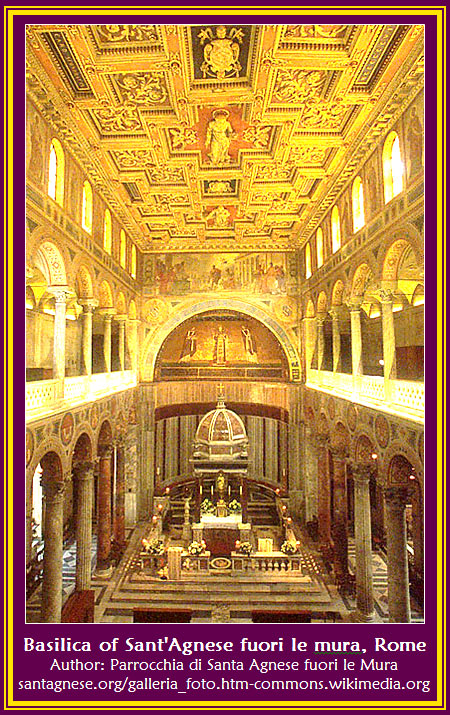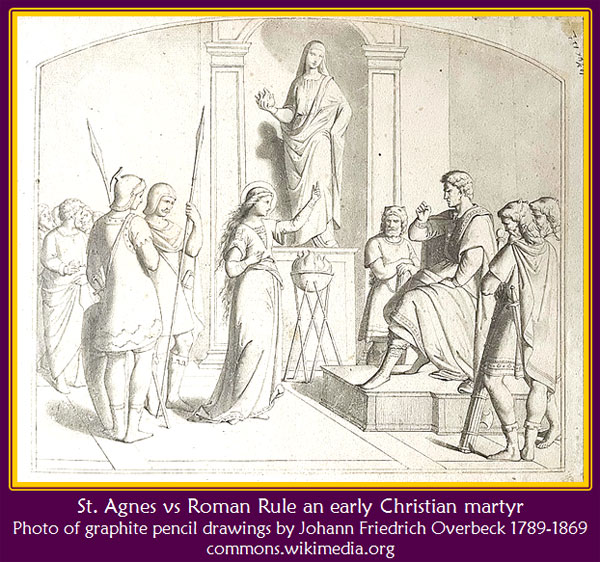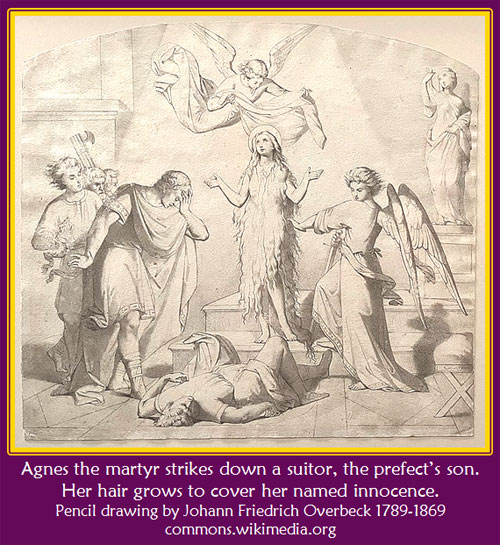
S. Agnes VM: Dormit in pace
(Part II of S. Agnes of Rome VM)
“My life belongs to Him who has chosen me the first.” – S. Agnes

Christianity took a victory lap after Constantine the Great took over Rome in the wake of his successful victory at the Milvian Bridge in 312. The days when secrecy of faith and worship was a necessity for the Christians living in pagan Rome due to their fear of detention gradually changed. Apart from the ancient places of Christian worship at the altars and chapels of the catacombs, small congregations used to assemble in private houses of their better-endowed Christian brethren. The interior of such private houses progressively converted as the congregations grew but a communal style of architecture for the churches recognisable as such to the public took shape only by the fourth century. As for the acquisition of burial grounds, it was a process that started in Rome in the second half of the second century, when Christian congregations began to acquire burial grounds for their members, the oldest being the catacombs in the south of Rome on the Appian Way.

Following the martyrdom of S. Agnes in c. 304, her parents buried her on the left side of Via Nomentana in an area of the Catacombs which later became known as Catacombe di S. Agnese (Coemeterium Agnetis) in the Complesso Monumentale S. Agnese (1). The Complesso is located in Quartiere Trieste.
Off Via Nomentana was the Coemeterium Maius which was the burial site of a catechumen named Emerentiana (Emerenziana) (2), the foster-sister of Agnes who was stoned to death at the tomb of Agnes soon after her funeral. The details of Emerentiana’s life are swathed in the mists of legend but it is related that both Agnes and Emerentiana were brought up in Christian faith by their mothers who bound their family together with love, good food and discipline.

My late wife Carina Renate (of blessed memory) and I have enjoyed extended visits to the unique and wonderful city of Rome where on many occasions we had the pleasure to explore Christian edifices, religious antiquity, and monumental ruins. Hereunder I single out only three old churches at Rome related to S. Agnes as space precludes me from entering further into this subject.

1) Basilica of St. Agnes Outside the Walls (Sant’Agnese fuori le Mura) is the present smaller basilica on the site of the saint’s grave at Catacombe di S. Agnese. Built and restored by Pope Honorius I (Reign: 625-638), Sant’Agnese fuori le Mura is partially below ground. It exists over the very spot of an older sacellum ad corpus (Chapel for the body) most likely erectedduring 337-366 when there was a rapid increase in the Christian community of Rome. That ancient shrine was subsequently restored by Pope Symmachus (498-514), a Sardinian convert who also built, among other edifices, the first papal residence next to S. Peter’s Basilica.

From the pontificate of Pope Paul V (Reign: 1605-1621) when the tomb of S. Agnes was exhumed to this day, the silver urn (given by Pope Paul V) containing the bones of S. Agnes is conserved beneath the high altar of Sant’Agnese fuori le Mura.

The same sarcophagus now contains the cache of bones of S. Emerentiana VM after her crypt (Chapel of the Chair) was discovered in a catacomb in the land gifted to the Christian community by the wealthy Ostorii family. The relics of S. Emerentiana were also noted during the archaeological excavations of Giovanni Battista de Rossi carried out in 1876 during the longest verified pontificate of Pius IX (1846-1878).

2) A few meters from Sant’Agnese fuori le Mura is the once grandiose edifice erected to commemorate the spot where the lifeless body of Agnes was laid in c 304. This edifice was founded by Roman emperor Constantine the Great (c. 274-337) (3) at the behest of Constantina (Flavia Valeria Constantia/Costantiniana/Costantia, c. 320-354), his daughter from Empress Flavia Maxima Fausta (c 293-326), his second wife.

In 337, following the death of her husband Flavius Hannibalianus (Annibalianus), Rex Regum, Constantina had sought the healing attributed to S. Agnes to cure her persisting skin ailment. Legend has it that S. Agnes appeared to Constantina in a dream entreating her to become Christian. The miraculous cure that took place the following morning turned Constantina into an ardent devotee of S. Agnes and before long, a basilica in the saint’s honour was built near Sant’Agnese fuori le Mura. Years later, when Constantina died at Bithynia (Asia Minor) in 354, her brother Emperor Constantius II (Flavius Julius Constantius, 317-361) took initiative to honour Constantina’s wish to repose by S. Agnes’ side. Her mortal remains were brought to Rome and interred in the (now well-preserved) Mausoleo di Santa Costanza (referred as Church of S. Costanza since 865. 4).

According to contemporary Antiochian historian Ammianus Marcellinus, six years after the passing of Constantina in 354, the lifeless body of Helêna, another daughter of Constantine and wife of Emperor Julian ‘the Apostate ’(Flavius Claudius Julianus, 331-363) (5), was brought from Gaul in 360 during the Quinquennalia Games and entombed in this Mausoleo.

From very early times S. Agnes was regarded as a singularly loved figure among the heroines of the days of persecution. Although portions of the catacomb of that area are of an older date than S. Agnes, out of devotion for S. Agnes, many noble Roman families chose these grounds for their sepulchre – to be nearer to the burial site of this celebrated saint. As years rolled on, that entire old burial area became known as the Catacombe di S. Agnese, one of the largest and most celebrated of Christian Rome.
Jo (Continued in Part III)

Notes:
- The Complesso Monumentale S. Agnese (current Sant’Agnese fuori le Mura) consists of the Catacombe Sant’Agnese, Sec. II-IV, Basilica Costantiniana Zona Archeologica Sec. IV, Mausoleo di Costanza Sec. IV and Basilica Onoriana Sec. VII. A trip to Rome is incomplete without savouring the fascinating ambiance of the Complesso Monumentale S. Agnese. A real gem in Rome – not to be missed by those who love ancient paintings, beautiful mosaic, unmodified architecture and history of the first ages of Christianity.
- Sant’Emerentiana (Emerenzia/ Emérentienne) is presumed to be a sister or foster-sister of S. Agnes. She was most likely one of the helpers during the burial of S. Agnes. Emerentiana’s feast-day is celebrated on January 23 but in the Martyrologium Hieronymianum she is mentioned under 16 September, with the statement: In cemeterio maiore;
- Constantine the Great was responsible for building many Christian basilicas (S. Peter’s, S. Paolo, S. Lorenzo, etc). He is also associated with monuments outside city limits and also at the Catacombs where they are erected on the site of the tombs of the martyrs and saints.
- The 4th century Mausoleo di S. Costanza, a sepulchral basilica (used as a baptistery for Sant’Agnese basilica and a popular chapel for wedding) has circular form similar to the Hadrian’s Mausoleum (Castel Sant’Angelo) and the Temple of Vesta, the Virgin goddess of the hearth and home in the Roman religion. This funerary complex was probably intended for Constantine I but his daughter Constantina inherited it after he was buried at the Church of the Holy Apostles in Constantinople. Together with the monumental red porphyry sarcophagus of S. Helena (Flavia Julia Helena, c. 250-c. 330), the mother of Constantine, the red porphyry sarcophagus of Constantina (Costantia) is presently preserved in the Museo Pio Clementino of Museo Vaticano Roma and a cast replica is kept in the Mausoleo di S. Costanza.
- Helena’s death in Gaul in 360 was caused by the effects of poison, which, according to Ammianus Marcellinus, had been administered three years earlier in Rome, by Eusebia Augusta, the beautiful but jealous second wife of Emperor Constantius II. It was believed that this act was not so much to kill Helena but to prevent her from ever bearing an heir to the throne. The mystery concerning Helena’s death was used by the enemies of her husband Emperor Julian (Flavius Claudius Julianus) to tarnish his reputation at the time.

(© Joseph Sébastine/Manningtree Archive)











